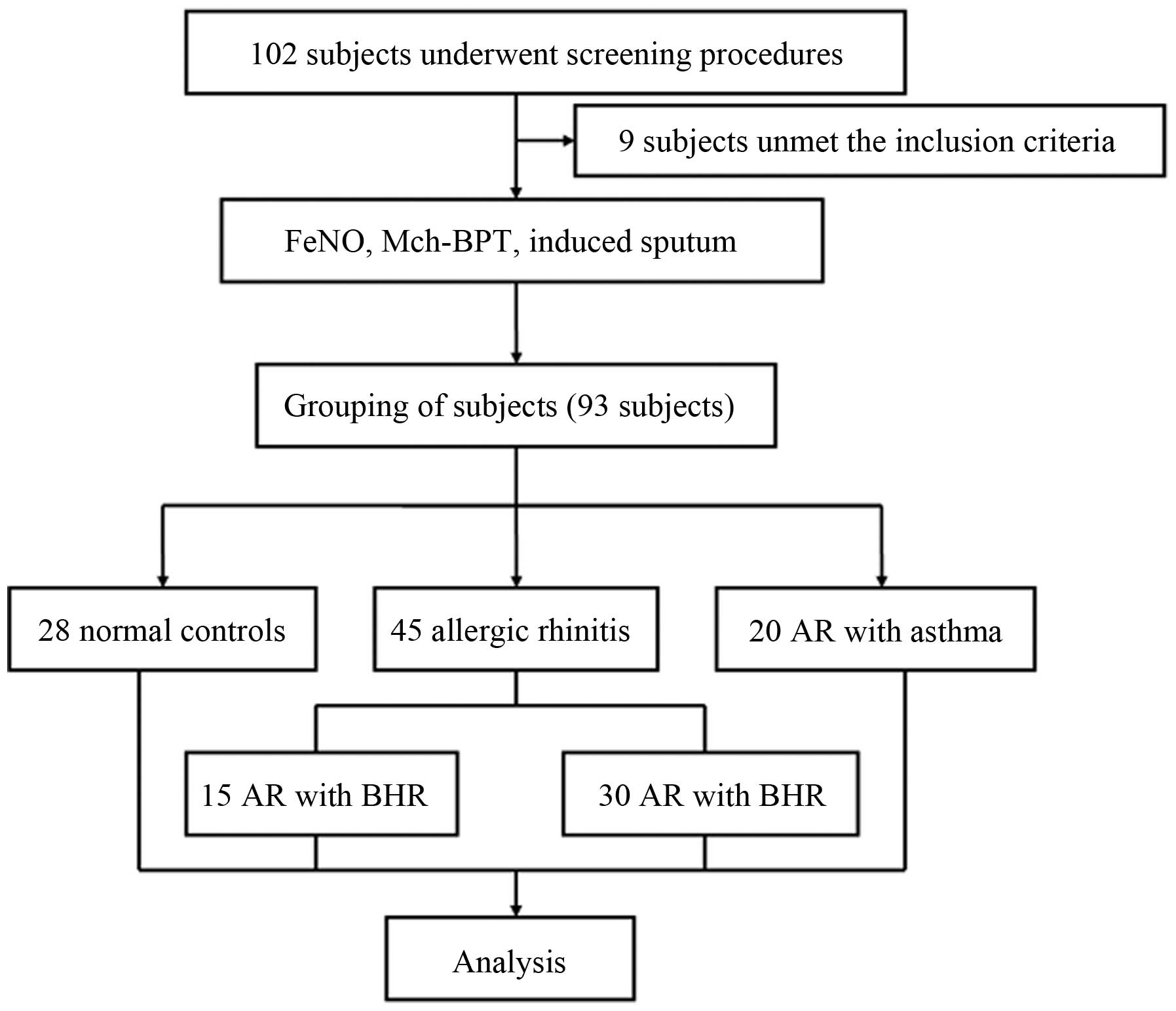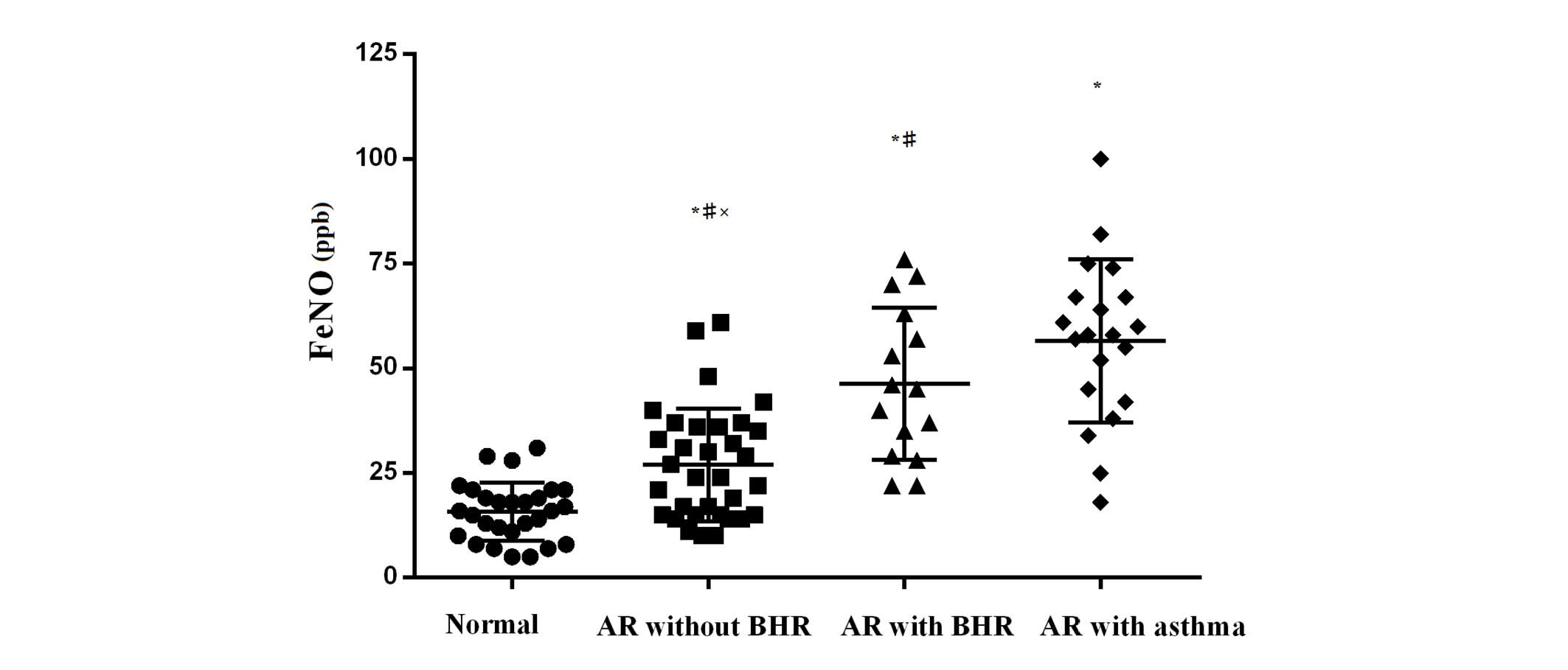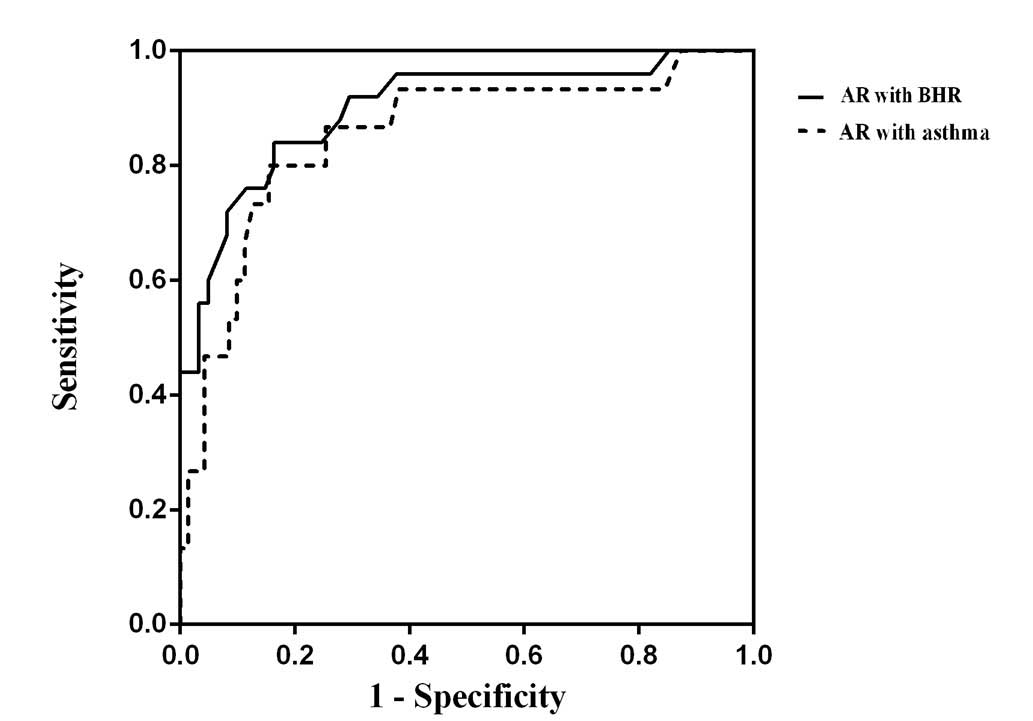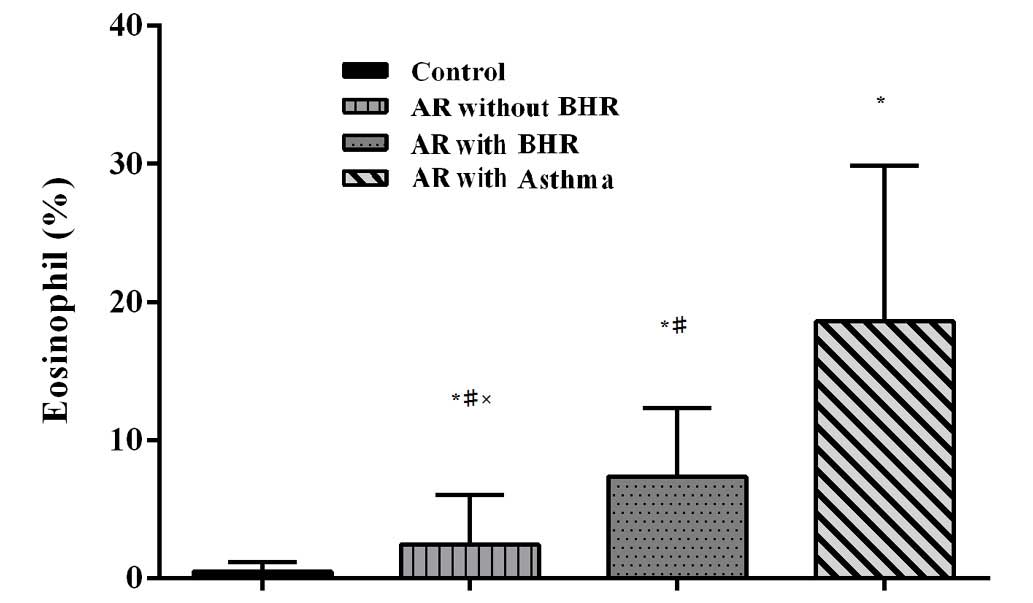|
1
|
Zhang Y and Zhang L: Prevalence of
allergic rhinitis in China. Allergy Asthma Immunol Res. 6:105–113.
2014. View Article : Google Scholar : PubMed/NCBI
|
|
2
|
Grossman J: One airway, one disease.
CHEST. 111:(2 Suppl). 11S–16S. 1997. View Article : Google Scholar : PubMed/NCBI
|
|
3
|
Lin J, Su N, Liu G, Yin K, Zhou X, Shen H,
Chen P, Chen R, Liu C, Wu C, et al: The impact of concomitant
allergic rhinitis on asthma control: A cross-sectional nationwide
survey in China. J Asthma. 51:34–43. 2014. View Article : Google Scholar : PubMed/NCBI
|
|
4
|
Bonay M, Neukirch C, Grandsaigne M,
Leçon-Malas V, Ravaud P, Dehoux M and Aubier M: Changes in airway
inflammation following nasal allergic challenge in patients with
seasonal rhinitis. Allergy. 61:111–118. 2006. View Article : Google Scholar : PubMed/NCBI
|
|
5
|
Linneberg A, Nielsen N Henrik, Frølund L,
Madsen F, Dirksen A and Jørgensen T: Copenhagen Allergy Study: The
link between allergic rhinitis and allergic asthma: A prospective
population-based study. The copenhagen allergy study. Allergy.
57:1048–1052. 2002. View Article : Google Scholar : PubMed/NCBI
|
|
6
|
Brozek JL, Bousquet J, Baena-Cagnani CE,
et al: Allergic Rhinitis and its Impact on Asthma (ARIA)
guidelines: 2010 revision. J Allergy Clin Immunol. 126:466–476.
2010. View Article : Google Scholar : PubMed/NCBI
|
|
7
|
Alvarez MJ, Olaguibel JM, Garcia BE, Tabar
AI and Urbiola E: Comparison of allergen-induced changes in
bronchial hyperresponsiveness and airway inflammation between
mildly allergic asthma patients and allergic rhinitis patients.
Allergy. 55:531–539. 2000. View Article : Google Scholar : PubMed/NCBI
|
|
8
|
Irvin CG: The nose: a window into the
asthmatic lung? Clin Exp Allergy. 40:839–840. 2010. View Article : Google Scholar : PubMed/NCBI
|
|
9
|
Bhimrao SK, Wilson SJ and Howarth PH:
Airway inflammation in atopic patients: a comparison of the upper
and lower airways. Otolaryngol Head Neck Surg. 145:396–400. 2011.
View Article : Google Scholar : PubMed/NCBI
|
|
10
|
Braunstahl GJ, Fokkens WJ, Overbeek SE,
KleinJan A, Hoogsteden HC and Prins JB: Mucosal and systemic
inflammatory changes in allergic rhinitis and asthma: a comparison
between upper and lower airways. Clin Exp Allergy. 33:579–587.
2003. View Article : Google Scholar : PubMed/NCBI
|
|
11
|
Smith AD, Cowan JO, Filsell S, McLachlan
C, Monti-Sheehan G, Jackson P and Taylor DR: Diagnosing asthma:
comparisons between exhaled nitric oxide measurements and
conventional tests. Am J Respir Crit Care Med. 169:473–478. 2004.
View Article : Google Scholar : PubMed/NCBI
|
|
12
|
Wang DY, Goh DY, Ho AK, Chew FT, Yeoh KH
and Lee BW: The upper and lower airway responses to nasal challenge
with house-dust mite Blomia tropicalis. Allergy. 58:78–82. 2003.
View Article : Google Scholar : PubMed/NCBI
|
|
13
|
de Graaf-int Veld C, Garrelds IM, Koenders
S and van Wijk R Gerth: Relationship between nasal hyperreactivity,
mediators and eosinophils in patients with perennial allergic
rhinitis and controls. Clin Exp Allergy. 26:903–908. 1996.
View Article : Google Scholar : PubMed/NCBI
|
|
14
|
Global Strategy for Asthma Management and
Prevention, . Global Initiative for Asthma (GINA). 2011, http://www.ginasthma.orgAccessed December
20, 2011.
|
|
15
|
Luo W, Lai KF, Chen RC, Chen QL and Zhong
NS: Establishment of reference values for cellularity in induced
sputum of healthy adults in Guangzhou. Guo Ji Hu Xi Za Zhi She.
16:1213–1215. 2007.(In Chinese).
|
|
16
|
American Thoracic Society; European
Respiratory Society, . ATS/ERS recommendations for standardized
procedures for the online and offline measurement of exhaled lower
respiratory nitric oxide and nasal nitric oxide, 2005. Am J Respir
Crit Care Med. 171:912–930. 2005. View Article : Google Scholar : PubMed/NCBI
|
|
17
|
Jiang CY, Zheng JP, Guan WJ, Xie YQ, Gao
Y, Liu QX, An JY, Yu XX and Liu WT: Reference ranges and predicted
equations for fractional exhaled nitric oxide in adult hans. Zhong
Guo Shi Yong Nei Ke Za Zhi. 8:608–613. 2012.(In Chinese).
|
|
18
|
Miller MR, Hankinson J, Brusasco V, Burgos
F, Casaburi R, Coates A, Crapo R, Enright P, van der Grinten CP,
Gustafsson P, Jensen R, Johnson DC, MacIntyre N, McKay R, Navajas
D, Pedersen OF, Pellegrino R, Viegi G and Wanger J: ATS/ERS Task
Force: Standardization of spirometry. Eur Respir J. 26:319–338.
2005. View Article : Google Scholar : PubMed/NCBI
|
|
19
|
Zheng JP and Zhong NS: Normative values of
pulmonary function testing in Chinese adults. Chin Med J (Engl).
115:50–54. 2002.PubMed/NCBI
|
|
20
|
Schneider A, Schwarzbach J, Faderl B,
Welker L, Karsch-Völk M and Jörres RA: FENO measurement and sputum
analysis for diagnosing asthma in clinical practice. Respir Med.
107:209–216. 2013. View Article : Google Scholar : PubMed/NCBI
|
|
21
|
Marcucci F, Passalacqua G, Canonica GW,
Frati F, Salvatori S, Dicara G, Petrini I, Bernini M, Novembre E,
Bernardini R, et al: Lower airway inflammation before and after
house dust mite nasal challenge: An age and allergen
exposure-related phenomenon. Respir Med. 101:1600–1608. 2007.
View Article : Google Scholar : PubMed/NCBI
|
|
22
|
Settipane RJ, Hagy GW and Settipane GA:
Long-term risk factors for developing asthma and allergic rhinitis:
a 23-year follow-up study of college students. Allergy Proc.
15:21–25. 1994. View Article : Google Scholar : PubMed/NCBI
|
|
23
|
Stachler RJ: Comorbidities of asthma and
the unified airway. Int Forum Allergy Rhinol. 5:S17–S22. 2015.
View Article : Google Scholar : PubMed/NCBI
|
|
24
|
Moshe S, Slodownik D, Yagev Y, Segal N,
Tavor M, Afek A and Zack O: Atopy as a risk factor for the
development of asthma in young recruits. J Asthma. 52:453–457.
2015. View Article : Google Scholar : PubMed/NCBI
|













